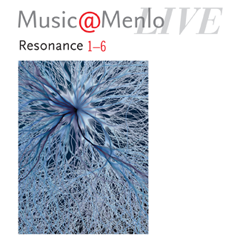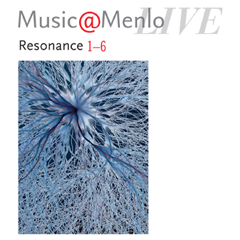
Another year, another wonderful set of live-recorded goodies from Wu Han and David Finckel's South Bay music festival, Music@Menlo. You're almost tempted to say, "Ho hum: Excellent festival is excellent. Film at eleven." But, as usual for Music@Menlo ("ho hum" again), there are performances here that it's a privilege to hear.
The 2012 season was on the theme of "Resonance," meaning (according to the program notes) "the many ways in which music resonates within the listener." I am not sure what that was intended to mean, exactly; it certainly encompassed (or allowed) a much more motley collection of works than did, say, the previous year's "Through Brahms."
Two things stand out in this set. One is the emphasis on the lesser-known of great composers' great works. Not the first Fauré piano quartet, but the second; not Dvořák's "Dumky" Trio, but its scandalously-underplayed Brahms-like predecessor, the F-minor Op. 65; not Beethoven's "Ghost" or "Archduke" Trios, but the "Ghost"'s opus-number sibling, the also-scandalously-underplayed Op. 70/2. The other is the amount of large-ensemble and indeed (small-)orchestral music. I don't recall the festival programming so much material of this kind before.
There are magnificent successes in this vein, like the chamber version of Copland's Appalachian Spring, as rhythmically taut and as calmly tender a performance as any I've heard, or like the spunky performance of Bartók's Rumanian Folk Dances in their string-orchestra guise.
But then there are strange misfires. The finale of Mahler's Fourth Symphony is here, in a chamber version. Instrumentally, it's first-rate, but Susanne Mentzer, with her deepish mezzo voice and pronounced vibrato, is not really the person to sing that part. She reappears in the set, in Respighi's Il Tramonto (The sunset), to much better effect.
Harpist Bridget Kibbey, a new name to me, is terrifically agile and subtle in two works. It's a mystery to me why the Festival programmed Debussy's Danses sacrée et profane (Sacred and profane dances) with strings one on a part. The score is full of divisi; there's a place in the first of the dances where a first violin solo is set off from the rest of the section, a great many octave doublings, and so forth. The performance here, of course, gets all the harmony in, but a fair bit of the texture is missing. It's lovely nonetheless.
Kibbey's other contribution is something much less frequently heard. André Caplet's Conte fantastique (Fantastic tale) is a sort of tone poem for harp and string quartet based on Edgar Allan Poe's story The Masque of the Red Death. For those who don't know the tale, it involves a country ravaged by a very nasty plague (more or less Ebola avant la lettre). The ruling prince gathers all his courtiers into his palace, barricades the doors against his subjects, and throws a fancy-dress party — to which the Red Death shows up in person, as it were.
Fine material for a composer, isn't it? You could listen to, and admire, this work with no idea of the plot, though the spot near the end where the harpist knocks on the resonating box of the instrument with her fist might puzzle you. Most of the piece is, naturally, revelry — not exactly innocent, but blithe.
The Festival always tries to include something Baroque, and it's invariably a bit stiff and awkward. If you get some way into the one-on-a-part account of Bach's B-Minor Suite here, there are many things to admire, but you have to fight your way through the slow introduction to the overture first. It's frustrating, because everyone is obviously trying to "get it right," with lovely, neat trills in all the right places and so forth, and yet the rhythmic and harmonic momentum and the gestural lift any good period-instrument orchestra would supply instinctively just isn't there. In general, the faster the movement, the better this performance, and at its best it's terrific.
So is nearly everything here. Besides the aforementioned Appalachian Spring, there's a jaw-dropping Schubert Fantasia from violinist Ben Beilman and pianist Juho Puhjonen. That's a violin part that has the ordinary effect of turning a violinist's left hand into knots, but Beilman scampers and sings throughout as if the technical aspects were no big deal; "never mind that stuff, just listen to what I want to say." You could say the same for the young Israeli pianist Inon Barnatan in the notoriously nasty co-solo part of Chausson's Concerto for violin, piano, and string quartet. His partner was Ani Kavafian, fiery as ever.
Have I mentioned the pianists? Besides Barnatan and Puhjonen, we have Gilbert Kalish and Jeffrey Kahane and (naturally) Wu Han, often two at a time.
No, it's not possible to enumerate all the things in here that demand to be heard. It's the usual Music@Menlo situation: a luscious grab-bag of chamber music, much of it unfamiliar, nearly all of it performed as well as you're ever likely to hear it, in excellent sound and before an audience that is quieter that you'd believe possible. Ho hum, not.



